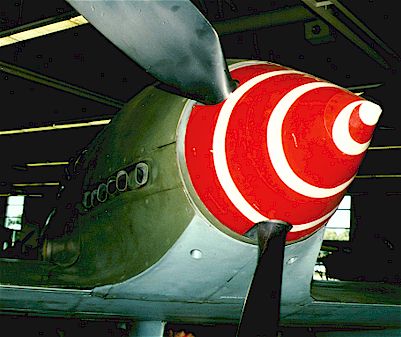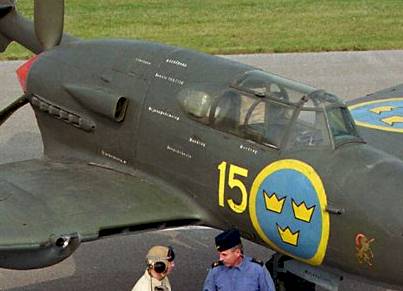by Martin Waligorski
Radical? Yes!
The unorthodox SAAB J 21 fighter was a domestic attempt to provide the Swedish Air Force with a true high performance fighter. It’s design was conducted during war years, when there was no practical possibility for Sweden to acquire modern aircraft from abroad.
Photo: SAABIn 1941 SAABs designer Frid Wänström presented the Air Force with concept of a fighter plane powered by a Daimler Benz liquid-cooled V-12 engine. Wänström proposed a push-propeller layout and a tricycle undercarriage. This configuration was expected to have several important advantages – excellent forward visibility, heavy armament concentrated in the fuselage, good landing characteristics. The Air Force did not accept the design at once, and for a period of time it seemed that the J 21 project would be abandoned in favor of the more conventional J 23. But finally, in December 1941, the go-ahead for the project was given.
presented the Air Force with concept of a fighter plane powered by a Daimler Benz liquid-cooled V-12 engine. Wänström proposed a push-propeller layout and a tricycle undercarriage. This configuration was expected to have several important advantages – excellent forward visibility, heavy armament concentrated in the fuselage, good landing characteristics. The Air Force did not accept the design at once, and for a period of time it seemed that the J 21 project would be abandoned in favor of the more conventional J 23. But finally, in December 1941, the go-ahead for the project was given.
At the same time the Air Force arranged for purchase and license production of Daimler Benz engines from Germany. This finally resulted in the purchase of seventy-plus DB 605B engines of 1475 hp in 1943 and a contract for license production. Actually, the first Swedish-made engine wasn’t delivered until after the war.
The J 21 emerged as a very advanced airframe with streamlined shape, twin tail booms, laminar wing profile and ejection seat for the pilot (which actually worked well in service, unlike some of the early ejection seat designs of German Luftwaffe). The first of the three prototypes made it’s maiden flight in July 1943. However, the first series machines were delivered in 1945.
Successful? Almost.
A total of 298 SAAB 21s were produced in five production batches. They served from 1946 to 1954.
Series aircraft were not without problems. Because of the propeller’s placement, engine cooling proved to be inadequate, especially on the ground – a serious problem that was never really worked out. The aircraft also lacked the agility necessary for a dogfighter. On a positive side, it proved to be a good gun platform and was easy to start and land.
These properties lead to the decision to adapt the J21 to ground attack role. The bomb-carrying version, the J21A-3, made its debut in May 1947, with the capacity for a 700 kg bomb load or 8 rocket projectiles. Because of the new role, the designation A21 or even B21 was used in service units (A=attack, B=bomber).
Worth mentioning is another advantage of the J21s layout. In 1947, SAAB converted the J21 to jet propulsion, installing the de Havilland Goblin instead of the DB 605. This new version was put into production as J21R. Thus the J21 became one of only two propeller-driven aircraft in the world that were successfully converted and produced as jets (the other one being Yak-3).
The J21A presented below has been preserved in Swedish Air Force museum in Linköping.
SAAB J21A in detail
J21 on display in the Linköping Museum’s main hangar. The first impression is that the aircraft sits very high on it’s spindly legs plus extra supports – making those interesting details hard to see. Compare with the full-scale pilot figure beside. This particular aircraft in in a late configuration, with wingtip fuel tanks and capability to carry bombs.
Photo: Martin Waligorski
J21s armament consisted of one 20mm cannon (in the middle) and four 13mm machine guns. Two of the guns are visible here, and two more were mounted in the wing pods. Note that the cannon barrel is slightly off-centre.
Photo: Martin Waligorski
Profile view of the nose and cockpit area. Photo: Martin Waligorski
Profile view of the canopy. Photo: Martin Waligorski
Close-up on the sliding portion of the canopy, starboard side (the front of the aircraft is to the right). Note the bulged perspex improving the rearward visibility, which, of course, was a problem on J21. Photo: Martin Waligorski
 No less than this long ladder was necessary for the pilot to access the cockpit.
No less than this long ladder was necessary for the pilot to access the cockpit.
The figure demonstrates a standard Swedish pilot outfit of the period.
Photo: Martin Waligorski
The propeller end of the fuselage. The straight contours of the propeller spinner are notable, as is the ”reversed” pitch of the blades. Photo: Martin Waligorski
I have to use this photo of another preserved machine to show the engine section of the fuselage. There is no way I could get a decent shot of it from the ground level!
Note the supercharger intake (naturally for DB engines, starboard side only), engine exhausts, and yet another view of the canopy. Thanks to SAAB for the photo. Photo: SAAB
 Nose undercarriage leg. The red element on this and other photographs is the guard keeping the oleo in extended position even with no pressure in the hydraulic system. Photo: Martin Waligorski
Nose undercarriage leg. The red element on this and other photographs is the guard keeping the oleo in extended position even with no pressure in the hydraulic system. Photo: Martin Waligorski
 Front wheel well had three covers, one opening to the port side for the leg, and two symmetrical ones over the wheel.
Front wheel well had three covers, one opening to the port side for the leg, and two symmetrical ones over the wheel.
Photo: Martin Waligorski
 Main undercarriage of the J21 simply retracted rearwards into the wing nacelles. It featured characteristic tractor-like tires.
Main undercarriage of the J21 simply retracted rearwards into the wing nacelles. It featured characteristic tractor-like tires.
Photo: Martin Waligorski
 Consequently, here’s a look into main wheel well on the port side.
Consequently, here’s a look into main wheel well on the port side.
Photo: Martin Waligorski
Cooler intakes were positioned in the wing roots, an aerodynamically efficient solution also seen on i.e. Mosquito or the Tempest. Landing lights were mounted in the front of each nacelle. The blanked-off stub outwards of the light was once a gun port of a 13mm machine gun. Bomb rack visible underneath was a distinctive feature of J21A-3 variant. Photo: Martin Waligorski
A better view of the wing center section and the bomb rack from below. J21 could carry a 600kg bomb on on this rack. The pylon was made extra tall to provide for the propeller clearance during the bomb drop.
Also note the cooling air outlets built into the wing’s lower surface. Photo: Martin Waligorski
 Control surfaces of the starboard wing seen from below…
Control surfaces of the starboard wing seen from below…
Photo: Martin Waligorski
..and lastly, a view of the starboard vertical tail.
Photo: Martin Waligorski
This article was originally published in IPMS Stockholm Magazine in February 2000.









